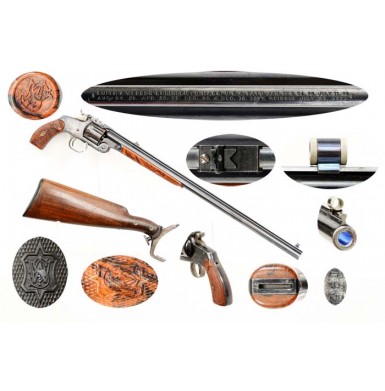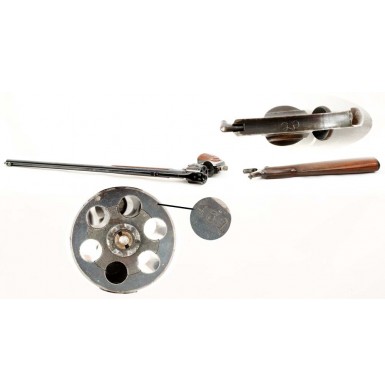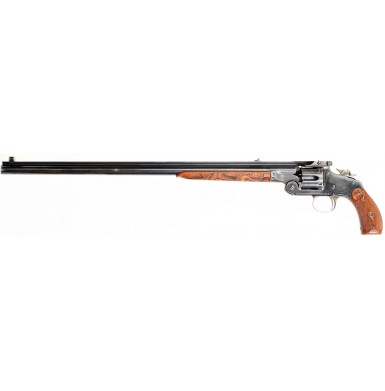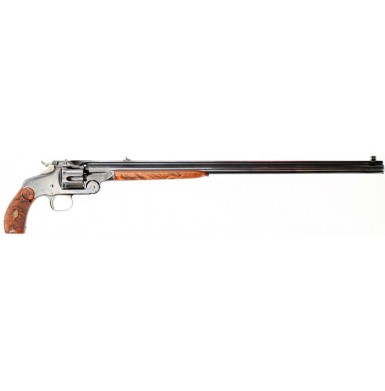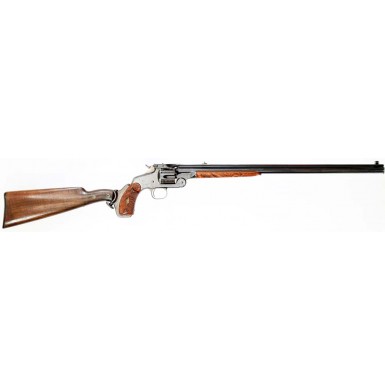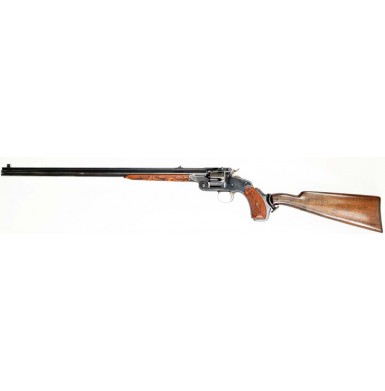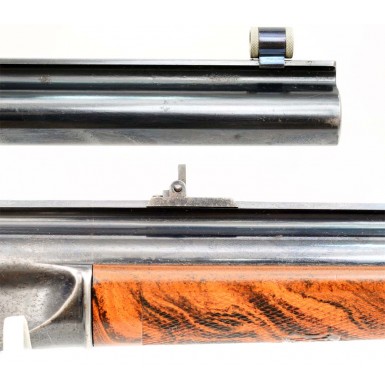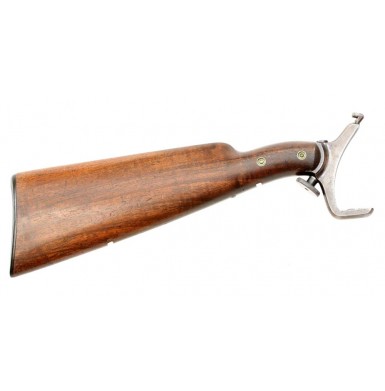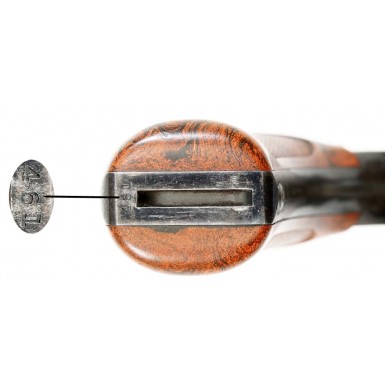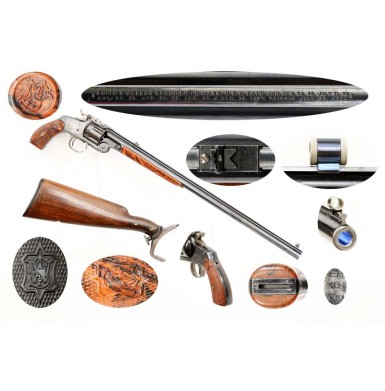Smith & Wesson 320 Revolving Rifle - Very Rare
- Product Code: FHG-1913-SOLD
- Availability: Out Of Stock
-
$1.00
In 1879 Smith & Wesson undertook to manufacture what would become one of the least often encountered of their firearms from the 19th century. The Model 320 Revolving Rifle was developed for a myriad of reasons, but in the end proved to be a commercial flop, an uncommon occurrence for a Smith & Wesson product during latter part of the 1800s. The concept of a revolving rifle was not a new one, with various manufactures offering models during both the flintlock and percussion ignition periods. For all practical purposes a revolving rifle was nothing more than a scaled up revolver, usually offering a longer barrel and better sights than a handgun, in conjunction with a shoulder stock. Both permanent and detachable stocks were used on various revolving rifle and carbine models, and in some cases the guns offered larger calibers than were available in a comparable handgun. The combination of features was designed to offer a repeating rifle during a period when most long guns were single shot weapons. The downsides to flintlock or percussion revolving rifles was that they were prone to chain fire (the premature ignition of an adjacent chamber to the one being fired) and the cylinder gap allowed the escape of hot gas and small shavings of lead when the rifle was fired. This meant that a flint or percussion revolving rifle could only safely be fired with the support hand behind or below the cylinder, rather than extended on the forearm where it would be with a standard rifle. Failure to follow this basic tenant of safety could result in the shooter suffering grievous injury when a chain fire placed a bullet in his or her support hand! For these two primary reasons, the revolving rifle concept never really gained traction and even Colt who had manufactured a fairly wide range of revolving long arms gave up on the concept by the middle of the 1860s. Colt also experimented with the concept of providing detachable shoulder stocks for some of their handguns (notably the Dragoon, 1851 Navy and 1860 Army), allowing the user to create an ersatz carbine for longer range, more accurate shooting. The system still had the same shortcomings and safety issues as other revolving longarms, and the offerings met with limited commercial success. By the mid-1860s the accessory stocks had essentially been dropped from their product line as well. Remington dabbled with the concept of a revolving carbine as well, based upon their New Model Army pistol action. However, it also met with minimal commercial success. Introduced in percussion in 1869, the offering was initially a percussion firearm, but was soon offered in a metallic cartridge conversion variant. The inherent flaws in the concept resulted in lackluster sales, and Remington withdrew the revolving carbine from the market in 1879 with less than 1,000 units being produced and sold. Given the track record of two of America’s most prominent gunmakers with revolving long arms, it would seem strange that Smith & Wesson would decide to enter that market. It appears that the popularity and success of their large frame, top-break revolvers had created a small ground swell of requests for a revolving long arm version. It appears that Smith & Wesson felt that the introduction of self-contained metallic cartridges, which eliminated the possibility of chain fires, effectively resolved the primary safety issue with a revolving rifle design. To this end they adopted their New Model Number 3 single action revolver to be a revolving rifle. The gun received modifications to the action allowing for an adjustable trigger pull, and extra-long barrels were produced specifically for this model. The offerings were 16”, 18” or 20”. The ribbed round barrels were so long that Smith & Wesson could not produce them as a single piece, and thus manufactured them as two parts, with a short piece of barrel, about 2” long, being screwed directly into the frame, and then the barrel extension of the requisite length being screwed into the shorter barrel. The rifles had a six-shot cylinder and a forend was provided forward of the frame on the bottom of the barrel. The upgraded sights consisted of an L-shaped leaf rear sight that was mounted in a dovetail on the top of the barrel near the receiver, and a blade front sight mounted on a block in a dovetail. A globe front sight was available as a factory option, as was a rear peep sight. The rifles were provided with a detachable shoulder stock that allowed the gun to be partially dissembled, reducing its overall length for more convenient storage or transport. While some references suggest the removable stock allowed the gun to be “more concealable”, it seems unlikely that anyone was concealing a revolver with a barrel between 16” and 20” in length! Standard finishes were either blued or nickel plated, with color case hardened hammers and triggerguards. The pistol grips and forend were made of mottled red and black hard rubber with checkering and the Smith & Wesson logo molded into them. The buttstock was of Circassian walnut (known as the “king of gunstock woods”) and had a black hard rubber buttplate that also checkering and the Smith & Wesson logo molded into it. The rifles were chambered for the proprietary Smith & Wesson 320 Rifle cartridge. This was a straight walled rimmed cartridge that fired a 98 to 100 grain round nosed, inside lubricated bullet, backed by 17 grains of black powder. The case was 1.465” in length and .345” in diameter. The bullet was seated flush with the case mouth, in an attempt to place the bullet as close the forcing cone as possible, reducing the distance from the chamber mouth to the barrel, in an attempt to improve accuracy. The only reference I could find regarding the ballistics of this round noted that it had a muzzle velocity of about 1,200 feet per second. This results in a muzzle energy of about 319 foot-pounds. By comparison, the Winchester .32-20 (.32 WCF) of the same era fired a bullet weighing between 85 and 115 grains at a velocity of between 1,110 Fps for the lighter load and 900 fps for the heavier bullet, resulting in muzzle energy of 228 ft-lbs for the 85 grain round and 207 ft-lbs for the 115 loading. Thus the S&W 320 cartridge was about 50% more powerful than the .32 WCF, but only provided the power of a modern .38 Special handgun target load; hardly the type of knock down power you would want out of a “rifle”. By way of further comparison, the muzzle energy of the S&W 320 was almost identical to that of the Smith & Wesson .44 Russian handgun cartridge, which was offered in S&W revolvers during that period. Even though the metallic cartridge eliminated the possibility of a chain fire, the shooter was still liable to get burned by hot gas escaping for the cylinder gap or showered with shards of molten lead if he placed his support hand on the forend of the rifle while shooting it. This factor alone was likely a serious sales deterrent. However, other factors combined to make the Smith & Wesson 320 Revolving Rifle a commercial flop. First, the revolving rifle concept made sense during the age of flintlock and percussion arms, when most long guns were single shot and no effective repeating rifle designs existed. Smith & Wesson decided to return to this outmoded design concept during a period when repeating lever action and slide action rifles were commonly available and bolt action magazine fed rifles were starting to appear on the market. The revolving rifle was simply an anachronism during a period of more refined repeating rifle designs. Second, the proprietary cartridge was inconvenient in that it was not a chambering found in other firearms, necessitating the carry of two different type of ammunition of the owner also carried a handgun. The most successful firearms of the western frontier era were predicated upon the concept of interchangeable calibers between handgun and rifle, thus the Winchester .44-40 (.44 WCF) and .38-40 (.38 WCF) were very popular as they could be used in both a rifle and handgun so chambered, meaning only one type of ammunition needed to be carried on the range. Finally, the proprietary cartridge offered minimal (if any) ballistic advantages over a standard handgun round, and was nearly half the power of the most commonly used handgun/rifle cartridge of the period the .44-40. As such, the Smith & Wesson 320 design was almost certainly doomed to fail while it was still on the drawing board. Only 977 of the rifles were produced, and while they were cataloged from 1879 through 1887, it appears that all of the production with the exception of six guns were produced in 1880. The additional six 320s were made in 1886 1887. In fact some Smith & Wesson correspondence, written long before the model was dropped from the catalog, noted that initial sales were so slow that it was unlikely that any more of the guns would be made. In total 977 of the Smith & Wesson 320 Revolving Rifle were produced, more than half of that number (514) with 18” barrels. An additional 239 were produced with 16” barrel and a 224 with 20” barrels. Factory records note that 840 of the guns were sold in the United States while the balance were exported, with England, France and Australia being the largest foreign consumers, with purchases of 65, 36 and 24 respectively. The very fact that the Model 320 was so unsuccessful during its time of production is the driving force behind the collectability and value of these guns today. Due to their rarity, the Model 320 has become of the of the most sought after guns to add to any advanced collection of Smith & Wesson firearms.
Offered here is an extremely rare Smith & Wesson Model 320 Revolving Rifle with the very scarce and desirable 20” barrel. As noted, only 224 Model 320s were produced with 20” barrels, making it the rarest of the standard production barrel lengths of 16”, 18” and 20”. Only 23% (less than 1 in 4) of all Model 320s were equipped with 20” barrels. The rifle is serial number 461, placing it about in the middle of production for the guns. According to factory records the number also places it in the middle of a batch of 20” Model 320 rifles that were produced in the #447-#488 serial number range. The matching serial number appears on the bottom of the butt, on the rear face of the cylinder, on the barrel catch, and in pencil inside the right grip panel. The top of the barrel rib is marked in two lines:
SMITH & WESSON SPRINGFIELD MASS. U.S.A. PAT’d JAN. 17 & 24. 63. JULY 11. 63
AUG. 24. 69 APR. 20. 75. FEB. 20 & DEC. 18 1877 REISSUE JULY 25. 1871
The barrel markings are flanked by a pair of Maltese crosses. The gun is in VERY FINE condition and retains about 80%+ of its original blued finish, with the expected fading and wear for a gun more than 130 years old. There is fading and loss at the points of contact and the high edges, with some flaked and faded loss on the frame and one area of rubbed finish loss about midway down the left side of the barrel. The finish shows some scattered flecks of minor oxidation mixed within the blue as well. The barrel and frame remain almost entirely smooth with some lightly scattered pinpricking present on the frame, above the hinge, forward of the cylinder and around the muzzle. The cylinder show more fading and loss of finish than the balance of the gun, retaining only about 20% vivid blue, most of which is in the cylinder flutes, with the balance of the cylinder having a dull bluish-gray patina with some brownish tones. The cylinder shows some light to moderate pinpricking on about one quarter of its surface, suggesting that it laid on that part of the cylinder for many years while stored. The hammer retains about 80% of its original color case hardened finish, with some fading and dulling towards a mottled gray. The triggerguard retains about 30% of its case hardening, with most having dulled and “silvered out” with the vivid colors being confined to the upper interior and front and rear webs of the guard. The fire blued trigger has faded to a smooth pale blue color. The action of the rifle is mechanically EXCELLENT and the cylinder times, indexes and locks up perfectly. The break open action functions as it should and the extractor still performs smoothly and precisely. The original L-shaped leaf rear sight is in place in the dovetail on the barrel, just forward of the frame and the original factory upgraded globe front sight is in place in the dovetail on top of the barrel, near the muzzle. The globe sight is missing the horizontal wire crosshair and the vertical crosshair is only attached at the top of the sight. The rifle has an EXCELLENT bore, which remains very bright and retains excellent rifling as well. The bore shows only some light frosting in the grooves and small amount of lightly scattered pinpricking, but really remains in outstanding condition. The mottled hard rubber grips are in wonderful condition and rate NEAR EXCELLENT. They are solid and free of any breaks, cracks or repairs. The grips retain sharp checkering and only show the most minor light handling marks. The hard rubber forend is in similarly outstanding condition and is also free from any significant defects. Both the grips and the forend retain crisply molded Smith & Wesson logos as well. The detachable Circassian walnut buttstock is in VERY FINE condition. The stock is solid and complete and free of any breaks, cracks, chips or repairs. The stock is scratch numbered 20 on the yoke. This is factory assembly or batch number and not a mating number or serial number. The stocks appears to have been made in batches and were not numbered to the guns in any way. The stock shows some scattered minor bumps and dings from handling and use, but no abuse. The blued metal attachment yoke retains about 40%+ original blue, with most of the blue on the left side and most of the loss due to fading on the right. The areas of loss have developed a smooth plum brown patina. The original black hard rubber buttplate is in place and remains in fine, undamaged condition, showing only some minor scuffing and handling marks, and retaining a crisp Smith & Wesson logo.
Overall this is a really wonderful example of a scarce Smith & Wesson Model 320 Revolving Rifle with a rare and desirable 20” barrel. With only 977 of the these revolving Smith & Wesson rifles produced, this is one of the rarest of all the Smith & Wesson firearms. As only 224 of the 20” rifles were manufactured, this rifle is the scarcest standard factory variant of those rare guns. The gun retains lots of original finish, is well marked, mechanically excellent and retains wonderful hard rubber grips and an equally fine forend. The buttstock is in wonderful condition as well and fits the gun perfectly. The Smith & Wesson Model 320 Revolving Rifle is one of the most desirable items to add to an advanced Smith & Wesson collection and is one of those guns many collectors dream of, but rarely have the opportunity to see in person, let alone purchase. This gun is in great shape, is 100% complete, correct and original and displays wonderfully. It is also reasonably priced compared to the few examples that have been on the market recently or sold at auction over the last few years. Don’t miss your chance to own one of the most coveted centerpieces for a Smith & Wesson collection. I am quite sure you will be extremely happy with this fine gun.
SOLD
